Domestic Container Service
-
- CONTAINER PORTS: Boxed in or Busting Out? Maritime Logistics Professional, Apr/May 2019 #26
Benchmarking the Nation’s top container ports in 2018 and looking ahead to what comes next.
The nation’s major ports finished 2018 and began 2019 setting monthly and yearly container volume records, but agitated trade activity in the White House raised questions about what corrections would be permanent and which would not.President Donald Trump said on Febuary 24 he is delaying the scheduled March 1 increase in the tariffs on $200 billion in Chinese imports. The president said on Twitter he wants to give negotiators more time to reach a comprehensive trade deal with Beijing. Tariffs on Chinese goods are set to increase to 25 percent from 10 percent unless the U.S. and China reach an agreement.
Research by the American Association of Port Authorities (AAPA) shows the trade sanctions will impact nine percent of the total volume of products imported and exported to the United States. Trade with China accounts for 16 percent of items moved in and out of California ports, 13 percent in Georgia and 12 percent in Washington State.
All that said, there is much to be happy about at the nation’s collection of boxports, and plenty more is happening in terms of infrastructure development. And, if the U.S. Department of Transportation’s projections that total freight tons moving on the nation’s transportation network will grow 49 percent in the next three decades, while the value of freight will almost double, are even close to being accurate, any short term uncertainties wrought by the prospect of a trade war will be eclipsed by the inertia of inevitable growth.
All that said; what’s happening in some of the nation’s busiest boxports is even more important. A selected look at the current landscape is an eye-opener:
San Pedro Bay Ports
Los Angeles, the nation’s busiest port in TEUs and fourth in value began 2019 on an accelerated pace, with a record 852,000 containers in January, a 5.4 percent increase over the same period last year when employees moved nearly 809,000 TEUs. January marked the seventh consecutive month the port handled more than 800,000 TEUs. The Port of Los Angeles finished 2018 processing a record 9,458,748 TEUs, compared with 9.34 million in 2017.More recently, Los Angeles handled 650,977 TEUs in March, an increase of 12.7 percent compared to 2018. For the first quarter of 2019, container volumes grew 4.6 percent. Despite global trade uncertainties, the port experienced strong first quarter growth, in part due to local supply chain stakeholders who achieved efficiency gains with a Port Optimizer that was rolled out in the first quarter. In total, for the first three months of 2019, the port’s volumes have increased 4.6 percent compared to the same period last year.
Port of Long Beach: Eclipsing 8 million TEU
The Port of Long Beach, the fifth largest U.S. port in terms of value, processed nearly 657,300 TEUs in January, down 0.1 percent from January 2018 when the port handled 657,800 TEUs. Despite lingering trade uncertainty, the Port of Long Beach had the second-busiest first quarter in its history, moving more than 1.8 million twenty-foot equivalent units (TEUs) January through March.Long Beach finished 2018 by also setting a record, moving the most cargo in its 108-year history: 8.1 million TEUs compared with 7.5 million in 2017. The achievement was a particularly impressive feat considering that cargo volumes slowed substantially in the second half of the year, illustrating the strength of cargo in the beginning of the year.
Port of NY & NJ breaks All-Time Annual Box Record
During 2018, the Port of New York and New Jersey handled more than 7 million TEUs for the first time in its history. The 7,179,788 TEUs handled allows the port to maintain its position as the busiest on the East Coast and the third busiest in the nation following Los Angeles and Long Beach. This was bolstered by an 8.2 percent increase in imported goods including clothing, furniture, electronics and other everyday products over the previous record for imports set in 2017. The Port handled one third of all containers on the East Coast of North America; an increase in market share of 2.8 percent over last year. Notably, the port also set a new all-time record for cargo handled by rail, moving 645,760 containers by rail, up 13.8 percent over the previous record set in 2017.The growth in part can be attributed to the completion in June 2017 of the Bayonne Bridge Navigational Clearance Project, which raised local air draft from 151 to 215 feet, allowing the world’s largest container ships to pass under it. Since the bridge project was completed, a dramatic increase in the size of vessels calling on the port means that 30 percent of containerized cargo now arrives on 9,000 TEU capacity tonnage, or larger.
Houston: new Port Chairman, new priorities
The Port of Houston also finished on a record note, moving 2.7 million TEUs in 2018, up 10 percent compared with 2017. January 2019 has seen a slight drop in TEU volume from 221,000 TEUs in 2018 to 215,000 last month.New Port Houston Chairman Ric Campo wants to fast-track the widening and deepening of the Houston Ship Channel and to harden and strengthen the resiliency of the port to withstand the impact from major storms and hurricanes.
In terms of container shipping, the Port of Houston Authority has voted to impose limits on large container ships calling on Houston Ship Channel terminals after petroleum shippers complained that the big ships would threaten export growth. The impact of that edict is yet to be determined, but the interim solution is intended to ensure unencumbered access to upper channel reaches.
Georgia on my mind
The Georgia Port Authority, which operates the Port of Savannah, moved 430,000 TEUs in January, up more than 90,000 TEUs from 2018’s 339,000. 2018 also closed with a record 4.35 million TEUs, compared with nearly 4.05 million in 2017. Most recently, Savannah handled more total containerized cargo and more intermodal rail volume, with greater connectivity and velocity, than any March on record, the Georgia Ports Authority reported.While the port handled more than 410,000 twenty-foot equivalent container units, an increase of 15.5 percent, rail volumes spiked by 26 percent for a total of 82,135 TEUs. In addition, GPA achieved a record low dwell time for intermodal boxes in March, with containers averaging just 27 hours from vessel to outbound rail. Savannah is leveraging its inland intermodal connections to expedite both volume and growth.
South Carolina Shines
The South Carolina Port Authority said January was a record, up 12.5 percent from 2018, making it the strongest January ever. The facility handled 205,700 TEUs compared with 167,000 TEUs in 2017. For 2018, the port processed a record 2.3 million TEUs, the third consecutive calendar year of record TEU volume for SCPA.“A strong February contributed to the Port’s continued growth, with container volume nearly six percent ahead of our financial plan for the first eight months of our fiscal year,” said Jim Newsome, SCPA president and CEO. Inland Port Greer handled 11,245 rail moves in February, bringing the facility’s fiscal year-to-date volume to 84,761 moves. Inland Port Dillon saw 2,688 rail moves in February and has handled 18,709 rail moves in FY2019. South Carolina is betting heavily on inland port infrastructure for the future, and recently signaled that it is exploring shortsea options to alleviate road congestion.
Calling on the Commonwealth
The Port of Virginia set a new annual record for container cargo volume, handling more than 2.85 million TEUs in calendar year 2018, a slight increase (0.5%) over last year's total. The port saw increases in volume at both Virginia Inland Port and Richmond Marine Terminal – the port’s two inland facilities – and truck and barge volume.“Our growth in 2018 was less than what we had planned for, but as construction proceeded at Virginia International Gateway (VIG) and Norfolk International Terminals (NIT), we made the decisions to temporarily hold some cargo and limit the movement of empty containers,” said John F. Reinhart, CEO and executive director of the Virginia Port Authority.
The Port of Virginia continued to move near-peak season cargo volumes, thanks in part to the completion of all 13 new container stacks at VIG, bringing the total number of stacks at the terminal to 28. The terminal has also nearly doubled its capacity for refrigerated cargo – growing from 452 plugs to 888 plugs. Four ship-to-shore cranes that arrived in January are scheduled to be placed into service by the end of March, and completion of the rail expansion is slated for June 2019.
Across the river at Norfolk International Terminals (NIT), 12 new stacks are handling cargo and the second phase of construction is now underway. The efficiencies gained from the new capacity; combined with the metered flow of cargo via the port’s Truck Reservation System is providing the port with much-needed breathing room after managing the most difficult aspects of the expansion.
Port of Jacksonville
SSA Marine will expand its footprint in Jacksonville, Florida, with the signing of a new 25-year lease extension that will also expand the Blount Island Marine Terminal to a total of 80 acres and includes a $28 million infusion towards a harbor-dredging project.The larger terminal and 47-foot depth at mean low tide will allow Jacksonville to handle up to two post-Panamax vessels simultaneously by 2023, enhancing the port’s ability to handle domestic container service to Puerto Rico, north-south routes, and trans-Pacific strings.
Loaded container volume at the Port of Jacksonville jumped 6.8 percent year over year to 879,934 TEU in 2018. The port handled 351,984 TEU of loaded imports last year, making it the eighth busiest import gateway on the US East Coast, with a 3.26 percent share of the market.
The Jacksonville Port Authority (JAXPORT) set a new record in March with the arrival of the largest boxship to ever call Jacksonville. The 11,000-TEU boxship is operated within the 2M alliance, which is comprised of Maersk, MSC, Hamburg Süd and strategic partners HMM and ZIM.
The port’s Asian container volumes continue to show significant growth, up 17 percent YTD, and JAXPORT’s Asian trade has grown robustly at 14 percent annually over the past five years. But JAXPORT faces a potential 10 percent decline in Asia import cargo since its terminal operator announced earlier this year that it entered into an agreement with Port Tampa Bay, and will cease working with the Port of Jacksonville in May.
CMA CGM was responsible for almost 12 percent of Jaxport's Asian container volume last year and for about 1.3 percent of Jacksonville's $68 million in revenue last year. CMA CGM is removing Jacksonville from its Pacific Express 3 route, the same route it will use in connecting to Tampa.
“We are confident that a significant amount of this business will stay in Jacksonville,” Jaxport Chief Commercial Officer Kristen DeMarco said, adding, “Moving it through another port would significantly add to the over-the-road transportation costs associated with trucking the cargo across the state.”
SeaTac Surges
The Northwest Seaport Alliance handled a record-breaking 775,522 TEUs in international volumes in the first quarter of 2019, a 12 percent increase over the same period last year. Total volumes from January through March equaled 932,288 TEUs and are up 11.1 percent, the second-highest first-quarter performance ever. Total container volumes for March reached 336,828 TEUs, an 11.3 percent increase from last year, with import and export volumes growing 16.7 percent and 8.6 percent, respectively.NWSA’s Managing Members also voted to approve lease agreements and authorize construction on Terminal 5 in Seattle. Once completed, the 185-acre terminal will be able to handle the ultra-large container vessels increasingly calling at West Coast ports. The deal potentially represents approximately a half-billion dollars of private and public investment in the region’s economy.
Notably, the NWSA also received four additional super-post-Panamax container cranes in March. The cranes will allow two 18,000-TEU vessels to dock simultaneously at Husky Terminal in Tacoma.
Oakland’s Historical High
The Port of Oakland, the nation’s seventh-busiest facility, processed nearly 209,500 TEUs in January, compared with 205,800 in 2018. For all of 2018 the port moved more than 2.5 million TEUs, compared with 2.4 million in 2017. 2018 was the busiest year in the Oakland history. Scrap paper shipments were up 3 percent in the first 10 months of 2018, contrasting with a generally challenging environment for U.S. exports. That’s important because waste paper is the largest export commodity, measured by container volume, shipped from Oakland.The Port said that it shipped the equivalent of 110,400 20-foot containers of wastepaper in 2018 through October; nearly 18 percent of Oakland’s total export volume, with much of that headed for Asia.
The good news was balanced by a local proposal to build a baseball stadium and thousands of housing units in close proximity to the port’s gates. Stakeholders fear that the proposal, if it comes to fruition, could negatively impact the port’s growth plans and efficiencies.
Wilmington, NC sets record
The Port of Wilmington set a record for container moves in the 2018 calendar year, NC Ports reported in a news release. The port had 175,500 container moves in the 2018 calendar year, up 23 percent from nearly 143,000 in the 2017 calendar year, according to numbers released by the port.Modest, though its box volume might be in comparison to other regional ports, NC Ports is banking heavily on leveraging the state’s considerable, multi-billion dollar agricultural trades, much of the output of which today goes to other regional ports. Port officials attributed the Port of Wilmington's efficiency in moving trucks and cargo through the port, as just one of the reasons for its overall increase in the movement of containers in 2018. A planned increase in reefer plug-ins as well as the arrival of the first-ever 12,000 TEU vessel to the Port of Wilmington, says port officials, bode well for the port’s future.
A nod to NOLA
The Port of New Orleans (Port NOLA) moved more containers in 2018 than at any time in its history, totaling 591,253 twenty-foot equivalent units (TEUs), up 12.3 percent compared to one year ago. Most importantly, those numbers included a 58 percent surge in containers moved by barge on the Port’s growing container-on-barge service operated in conjunction with the Port of Greater Baton Rouge.A recently announced Marad grant of $3.1 million will support the barge service, allowing them to purchase purpose-built vessels that will increase the viability of the service. As Louisiana’s chemical industry grows, the barges are essential to increasing the capacity of the shuttle, intermodal efficiency and reducing costs. The existing container on barge service currently moves approximately 16,800 FEUs between Memphis/Baton Rouge and New Orleans, operating twice weekly to deliver export cargo that will be loaded on deep-draft container ships.
Also of note, the New Orleans Public Belt Railroad, which the Port acquired in 2018, realized a 15 percent growth in intermodal cargo and new connections with domestic markets.
PhilaPort: open for business
The Port of Philadelphia (PhilaPort) saw cargo volume growth accelerate in advance of the completion of a $392 million project to deepen the port’s primary channel and the implementation of a $300 million capital improvement project. PhilaPort has seen a 166 percent container growth in the past decade and in 2018 handled a record 600,000 TEU.David Whene, president of Greenwich Terminals, operator of the Packer Avenue Marine Terminal, said, “With ship productivity as high as 140 gross moves per hour, turn-times of under 40 minutes, and an abundance of available chassis, Packer Avenue offers carriers unparalleled efficiency in reaching the Mid-Atlantic region and beyond.”
The upcoming completion of the Delaware River Deepening Project will provide a 45-foot shipping channel through Philadelphia, allowing vessels as large as 14,500 TEUs to call at the port. That deepening project is timed perfectly with the arrival of new Post-Panamax cranes, bringing the total operational cranes on the terminal to six (a seventh will arrive in August).
Rick Eyerdam is an award winning journalist and editor. Formerly, he was Editor of Florida Shipper Magazine. Additionally, he was Executive Director of the Miami River Marine Group and Captain of the Port of the Miami River. He is a graduate of Florida State University with majors in English and Government. His articles have appeared in myriad shipping magazines and newspapers since 1970.
This article first appeared in the MAR/APR edition of Maritime Logistics Professional magazine.
-
 )
March 2024 - Marine Technology Reporter page: 48
)
March 2024 - Marine Technology Reporter page: 48Index page MTR MarApr2024:MTR Layouts 4/4/2024 3:19 PM Page 1 Advertiser Index PageCompany Website Phone# 17 . . . . .Airmar Technology Corporation . . . . . . . . . .www.airmar.com . . . . . . . . . . . . . . . . . . . . . . . . . . . . . . . . .(603) 673-9570 9 . . . . . .Birns, Inc. . . . . . . . . . .
-
 )
March 2024 - Marine Technology Reporter page: 45
)
March 2024 - Marine Technology Reporter page: 45ronments. The new agreement will address speci? c techni- cal gaps in the UUV defense and offshore energy markets especially for long duration, multi-payload mission opera- tions where communications are often denied or restricted. As part of the new alliance, Metron’s Resilient Mission Autonomy portfolio
-
 )
March 2024 - Marine Technology Reporter page: 35
)
March 2024 - Marine Technology Reporter page: 35safe for the trashcan and can be purchased from vendors such as Digikey. Numerous land? lls once fully discharged, which manufacturers say can domestic manufacturers will assemble cells into custom bat- be done by dropping the pack into a bucket of saltwater. tery packs. (Google “Custom battery pack
-
 )
March 2024 - Marine Technology Reporter page: 25
)
March 2024 - Marine Technology Reporter page: 25gathered by RV Tanga- NIWA statement from November 2022. that couples into the water column.” roa outside the caldera.” In all, Maxlimer Tonga’s severed domestic internet cable mapped more than 800 km2 and travelled was buried under 30 m of ash and sedi- TESMaP Makes it Mark 1331 nautical miles over 34 days
-
 )
March 2024 - Marine Technology Reporter page: 9
)
March 2024 - Marine Technology Reporter page: 9from marinas along the western coast. The exact number of lizing laser detection systems can detect mines just below the mines, as well as their locations, remains largely a mystery, surface, even those hiding in murky water. The Airborne Laser although reports suggest that over three hundred have been
-
 )
March 2024 - Marine Technology Reporter page: 6
)
March 2024 - Marine Technology Reporter page: 6MTR Editorial Advisors Gallaudet Hardy The Honorable Tim Gallaudet, Kevin Hardy is President PhD, Rear Admiral, U.S. of Global Ocean Design, Navy (ret) is the CEO of creating components and Ocean STL Consulting and subsystems for unmanned host of The American Blue vehicles, following a career
-
 )
March 2024 - Marine Technology Reporter page: 4
)
March 2024 - Marine Technology Reporter page: 4Editorial NIWA-Nippon Foundation TESMaP/ Rebekah Parsons-King www.marinetechnologynews.com ast month marked the resounding NEW YORK 118 E. 25th St., New York, NY 10010 return of Oceanology Interna- Tel: (212) 477-6700; Fax: (212) 254-6271 tional in London, perennially one Lof the world’s most important
-
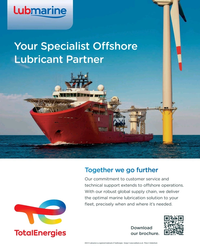 )
April 2024 - Maritime Reporter and Engineering News page: 3rd Cover
)
April 2024 - Maritime Reporter and Engineering News page: 3rd CoverYour Specialist Ofshore Lubricant Partner T Togeth her w we go o furt ther r Our commitment to customer service and technical support extends to ofshore operations. With our robust global supply chain, we deliver the optimal marine lubrication solution to your ?eet, precisely when and where it’s needed.
-
 )
April 2024 - Maritime Reporter and Engineering News page: 48
)
April 2024 - Maritime Reporter and Engineering News page: 48Index page MR Apr2024:MN INDEX PAGE 4/5/2024 1:33 PM Page 1 ANCHORS & CHAINS MILITARY SONAR SYSTEMS tel:+44 (0) 1752 723330, [email protected] , www.siliconsensing.com Anchor Marine & Supply, INC., 6545 Lindbergh Houston, Massa Products Corporation, 280 Lincoln Street, SONAR TRANSDUCERS
-
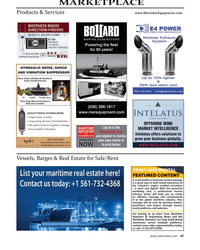 )
April 2024 - Maritime Reporter and Engineering News page: 47
)
April 2024 - Maritime Reporter and Engineering News page: 47MARKETPLACE Products & Services www.MaritimeEquipment.com Powering the fleet for 60 years! HYDRAULIC NOISE, SHOCK AND VIBRATION SUPPRESSOR Noise, Shock, VibraO on & PulsaO on in Quiet, Smooth Flow Out Oil Bladder Nitrogen (blue) Manufactured by MER
-
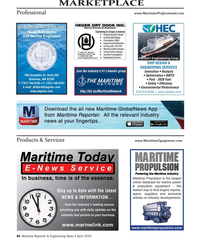 )
April 2024 - Maritime Reporter and Engineering News page: 46
)
April 2024 - Maritime Reporter and Engineering News page: 46MARKETPLACE Professional www.MaritimeProfessional.com GILBERT ASSOCIATES, INC.GILBERT ASSOCIATES, INC. Naval Architects and Marine Engineers SHIP DESIGN & ENGINEERING SERVICES Join the industry’s #1 Linkedin group )NNOVATION
-
 )
April 2024 - Maritime Reporter and Engineering News page: 43
)
April 2024 - Maritime Reporter and Engineering News page: 43“The industry is an ecosystem which includes owners, managers, mariners, shipyards, equipment makers, designers, research institutes and class societies: all of them are crucial,” – Eero Lehtovaara, Head of Regulatory & Public Affairs, ABB Marine & Ports All images courtesy ABB Marine and Ports provi
-
 )
April 2024 - Maritime Reporter and Engineering News page: 41
)
April 2024 - Maritime Reporter and Engineering News page: 41to build guidance owners and operators, has also joined us. ? eet. We see demand continuing to grow into the system so watchkeepers can from both domestic and international more easily assess the options they have Machine Vision shipowners, and we are also seeing in- for responding to challenging situations
-
 )
April 2024 - Maritime Reporter and Engineering News page: 38
)
April 2024 - Maritime Reporter and Engineering News page: 38Tech Files Latest Products, Systems and Ship Designs Zero-Emission Mooring Service of a Tanker Consulmar achieved a milestone by executing what it calls ing boat Castalia, which operates on full electric propulsion. the world's ? rst zero-emissions mooring service for a tanker. Equipped with two 150 kW
-
 )
April 2024 - Maritime Reporter and Engineering News page: 28
)
April 2024 - Maritime Reporter and Engineering News page: 28FEATURE INTERVIEW track missiles and warheads for the Mis- sile Defense Agency, and it travels with its support ship, the MV Hercules. For our Service Support ships, we have the two hospital ships, USNS Mer- cy and Comfort; two rescue and salvage ships; two submarine tenders; and the Sixth Fleet ?
-
 )
April 2024 - Maritime Reporter and Engineering News page: 27
)
April 2024 - Maritime Reporter and Engineering News page: 27RADM PHILIP SOBECK, MILITARY SEALIFT COMMAND With COVID, we had to make some hard choices for our Do your CIVMARs have upward mobility? mariners because we couldn’t rotate. Many of our mariners The Navy has Sailors who become “Mustangs,” and work found other employment, and were able to use their skills
-
 )
April 2024 - Maritime Reporter and Engineering News page: 25
)
April 2024 - Maritime Reporter and Engineering News page: 25RADM PHILIP SOBECK, MILITARY SEALIFT COMMAND Photo by Brian Suriani USN Military Sealift Command From a global supply chain perspective, What makes MSC so vital to the we’ve learned a lot about dealing with Navy’s ? eet and our military disruptions. COVID delivered a big forces around the world? wake-up
-
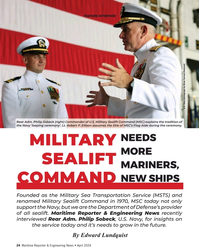 )
April 2024 - Maritime Reporter and Engineering News page: 24
)
April 2024 - Maritime Reporter and Engineering News page: 24FEATURE INTERVIEW U.S. Navy photograph by Brian Suriani/Released Rear Adm. Philip Sobeck (right) Commander of U.S. Military Sealift Command (MSC) explains the tradition of the Navy ‘looping ceremony’. Lt. Robert P. Ellison assumes the title of MSC’s Flag Aide during the ceremony. NEEDS MILITARY MORE
-
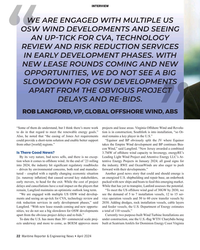 )
April 2024 - Maritime Reporter and Engineering News page: 22
)
April 2024 - Maritime Reporter and Engineering News page: 22INTERVIEW WE ARE ENGAGED WITH MULTIPLE US OSW WIND DEVELOPMENTS AND SEEING AN UP-TICK FOR CVA, TECHNOLOGY REVIEW AND RISK REDUCTION SERVICES IN EARLY DEVELOPMENT PHASES. WITH NEW LEASE ROUNDS COMING AND NEW OPPORTUNITIES, WE DO NOT SEE A BIG SLOWDOWN FOR OSW DEVELOPMENTS APART FROM THE OBVIOUS
-
 )
April 2024 - Maritime Reporter and Engineering News page: 21
)
April 2024 - Maritime Reporter and Engineering News page: 21ROB LANGFORD, VP, GLOBAL OFFSHORE WIND ob Langford has worked in the offshore industry ABS. “We are growing and evolving our services across all for more than three decades, ‘cutting his teeth’ offshore infrastructure along with our continued support to the in a UK design ? rm working in the North Sea
-
 )
April 2024 - Maritime Reporter and Engineering News page: 16
)
April 2024 - Maritime Reporter and Engineering News page: 16MARKETS SOVs – Analyzing Current, Future Demand Drivers By Philip Lewis, Director of Research, Intelatus © Björn Wylezich/AdobeStock t a high-level, there are three solutions to transferring Lower day rate CTVs are often used for daily transfer of technicians from shore bases to offshore wind farms
-
 )
April 2024 - Maritime Reporter and Engineering News page: 13
)
April 2024 - Maritime Reporter and Engineering News page: 13from gasoline to methanol, but compared to just buying an EV After some pondering, I think I can reduce it to this logi- today that is a pointless exercise. It would actually make more cal sequence: sense to buy a plug-in hybrid that is con? gured for methanol It is the carbon. We want zero carbon as
-
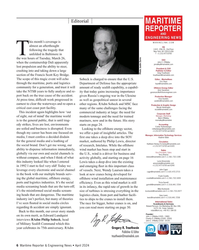 )
April 2024 - Maritime Reporter and Engineering News page: 6
)
April 2024 - Maritime Reporter and Engineering News page: 6Editorial MARITIME REPORTER AND ENGINEERING NEWS his month’s coverage is M A R I N E L I N K . C O M almost an afterthought HQ 118 E. 25th St., 2nd Floor following the tragedy that New York, NY 10010 USA T +1.212.477.6700 Tunfolded in Baltimore in the wee hours of Tuesday, March 26, CEO John C.
-
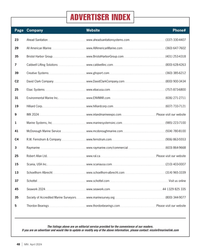 )
April 2024 - Marine News page: 48
)
April 2024 - Marine News page: 48ADVERTISER INDEX Page Company Website Phone# 23 Ahead Sanitation www.aheadsanitationsystems.com (337) 330-4407 29 All American Marine www.AllAmericanMarine.com (360) 647-7602 35 Bristol Harbor Group www.BristolHarborGroup.com (401) 253-4318 7 Caldwell Lifting Solutions www.caldwellinc.com (800)
